If you want to examine the material in a particular Market, select a market segment using the Market button above. Select Markets to return to Markets page. Other links will take you to other destinations.
Gunite and Shotcrete
The term "Shotcrete" means sprayed concrete. "Gunite" is another term often used for sprayed cementitious materials. Generally, the term "Gunite" is used if sprayed mortar is discussed. Both shotcrete and gunite are spray applied. There are different types of machines that are in use. Dry mix shotcrete is air conveyed from the "gunite" machine. That means that the mix is "blown" by high volume air through rubber hoses to the spraying nozzle. The water that is needed to hydrate the cement is added at the nozzle. Wet mix shotcrete is pumped concrete. The concrete is mixed and then pumped through hoses to the nozzle. High pressure air, then accelerates the mix through the nozzle.
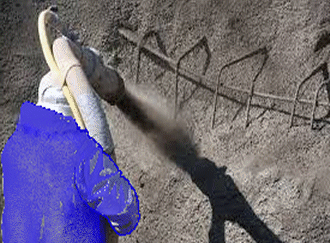 |
Shotcrete or gunite was not viable until the ability to compress air became available. The air compressor was only developed around the late 1890's. At first, they were driven by leather drive belts, attached to water wheels, or steam engines. Initially, the air was pumped using bellows. Steam had been harnessed to provide power for driving pumping equipment, but until the development of the high pressure steam engine in about 1800, steam engines were bulky, and as difficult as water wheels to place where compressors were required. The diesel engine was invented in 1898 and immediately more suitable air compressors began to be developed. The piston compressor was developed in 1904. Once the diesel engine and compressors were unitised, mobile machines became a viable option.
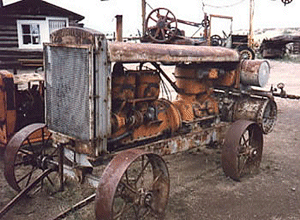 |
Carl Ethan Akeley developed the first "Gunite" machine. The first machine he made was used to spray Plaster of Paris. Legend claims that the museum staff built animals and scenery out of sprayed materials. The story is told that he made the "squirt-gun" machine to build models of dinosaurs. The truth is that in the spring of 1907, Carl Akeley was working with Clarence Dewey in a museum workshop. They had made some imitation rocks which they were painting. They were using a "squirt-gun" that Carl had made to squirt paint onto the imitation rocks.
The building where they were working was old and dilapidated. The museum director, Frederick Skiff, went looking for Akeley in the workshop. While he was there he saw Clarence Dewey, Carl Akeley's assistant spraying Plaster of Paris onto imitation rocks. He said to Carl, "Ake, why can't you and Dewey make a big machine, like that squirt-gun Clarence is using, and paint this old tumbled-down shack with Plaster of Paris?" Akeley, who was amazingly versatile, took up the challenge. He built a machine, which he named a "plaster gun." It forced dry plaster through a hose using compressed air. The plaster was a mixture of cement and sand. When the plaster reached the nozzle, water was added from another hose and the mix was squirted onto the museum walls. Gunite was born!
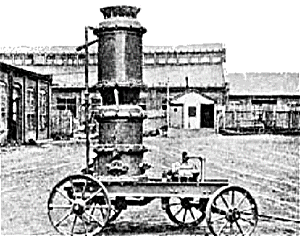 |
In 1910, the "Cement Gun" was exhibited at a Cement Show in Madison Square Garden. Delegates at the show were very impressed and the gun's potential was quickly realised. Soon, contractors were finding ways to use the new technology. An early contract used sprayed plaster linings to repair the Hunter's Brook Siphon concrete waterway, in New York. Pneumatically applied plaster, which was how it was described in those early days, quickly became commonplace. Many different structures were repaired. Originally, all gunite material was produced as a dry-mix material. It was only possible due to the development of compressed air; because using compressed air, the material could be blown onto the surfaces through the nozzle.
Machines and Methods
Today, shotcreters and guniters can chose a whole range of materials to use. They can decide to spray wet concrete that is cohesive and has stone particles in the mix. Or they can use dry mixes with air conveyed material. Heavier stone is not so suitable for dry batches and rebound can be a problem. However, much of the rebound can be controlled by using condensed silica fume. Rotating drum machines are commonly used for dry mixes. Piston pump types are often used for wet concrete shotcrete. When fibre reinforced mortars are used, the cement and sand slurry mix is pumped to the chopper gun head by a mono pump, which has a spiral shaped rotor running in a rubber stator.
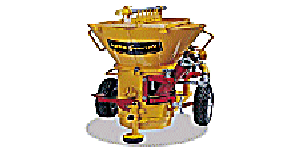 |
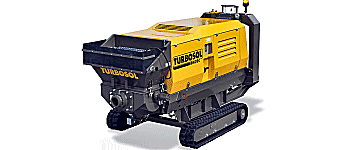 |
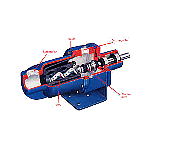 |
Different type nozzles are used for the spraying systems used with the dry mix gunite, wet mix shotcrete and sprayed mortar machines. Dry gunite is extensively used in the building of swimming pools. Wet shotcrete is often used for embankment stabilisation and in tunnel linings. Spray applied mortar is used for fibre reinforced concrete. (Glass reinforced concrete was used for facades, etc., but glass reinforcing is affected be cement alkalinity).
Wet shotcrete is conveyed through hoses from the pump to the nozzle. It is already mixed to the right consistency, so no further water is added. At the nozzle the velocity of the mix is increased and a further increase in velocity is obtained by means of the venturi shape inside the replaceable nozzle.
Dry shotcrete is popular because the application runs can be shortened. The dry cement does not become activated until it reaches the nozzle, where sufficient water is injected into the mix. The nozzle can also have an air injection point to assist in increasing the velocity at which the mix is shot from the nozzle.
With fibre reinforced Mortar mixes, the system produces a thin matrix of mortar with cut fibre embedded into the matrix. The use of a chopper gun slices lengths of fibre from a bobbin of assembled roving. The slices pact in a random pattern on the mould or shutter, and are encapsulated by the mortar.
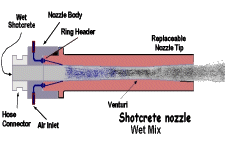 |
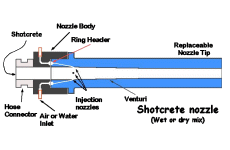 |
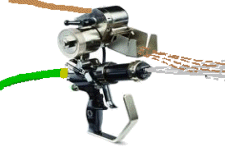 |
Shotcrete and gunite are used extensively in the mining industry. Mostly used for rock support, although dams and other items can be constructed. This aspect will be covered in a more detail in the mining segment of this website but it is good to highlight its importance here.
Fibres and mesh are used extensively to reinforce concrete. Concrete has outstanding compressive characteristics, but the material does not exhibit tensile strength, and due to this inherent weakness, materials are used to provide the tensile strength that is lacking. When subjected to tensile or expansive loading, concrete will crack. It will also crack due to shrinkage. To counteract shrinkage and cracking reinforcement is used.
Fibre reinforced shotcrete is gaining popularity. There are basalt, steel, and polymer fibres available. The materials are added by mass to the mix. Basalt fibre and mesh is made from lava rock, and is inert. Because steel is heavier than polypropylene, the steel addition level is higher than that of polymers. Fibre design is important because, with some fibres, balling can occur. Prior testing to determine mixing capabilities and balling resistance should be carried out. Basalt fibre does not exhibit balling tendencies. Mesh reinforced concrete has supported 70 ton loads on a 100 mm thick panel, and gives an equivalent of 850 joules of energy.
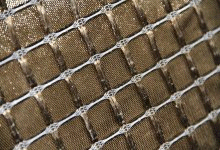 |
Information on dosage, energy absorption capability, (Efnarc panel test, or similar,) aspect ratios, (fibre length divided by diameter), toughness, and performance criteria can be obtained from the suppliers. Steel fibre can only be used successfully in certain types of shotcreting machine. Their use in peristaltic, or diaphragm type, wet shotcreting machines is not recommended as the steel can pierce the flexible rubber components.
Basalt fibres are still "the new kid on the block". They are being subjected to testing all around the world. Basalt mesh have produced extremely good results, and because of their light weight, and ease of placement, these products will find rapid acceptance. Some polypropylene fibres are demonstrating high-energy absorption qualities. The latest materials seem to have higher adhesion rates and seem to disperse well in the shotcrete mixes. The price of polypropylene fibre is higher than that of steel, but the lower loading rate offsets some of the additional costs. The same price limitations apply to basalt fibres.
 |
We pride ourselves on our professional service, market knowledge, quality, and most competitive prices. Contact us if you require further information. Some applications are more fully described in downloadable "pdf" files.
Return to Top of Page.